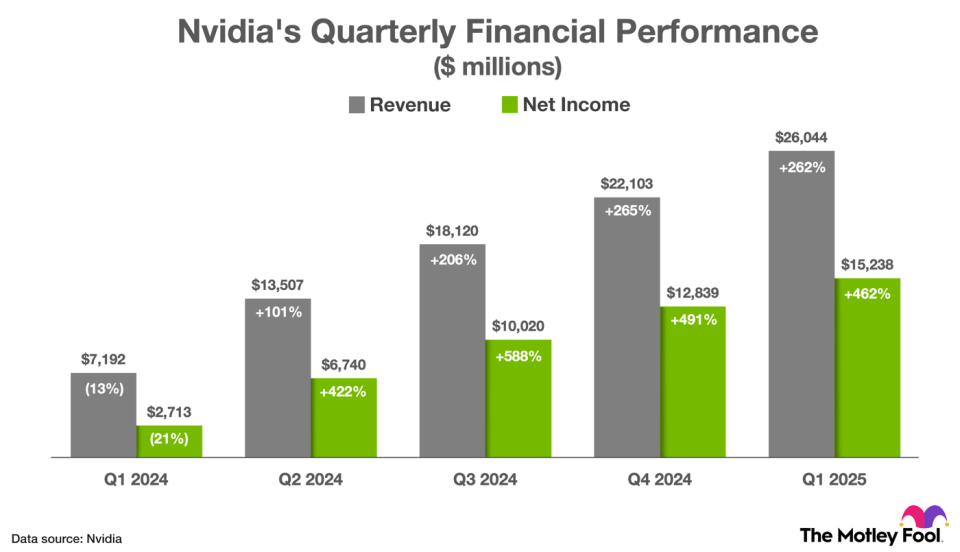Nvidia (NASDAQ: NVDA) recently executed a 10-for-1 stock split to reset its share price, which had surged 725% during the preceding 18 months. The driving force behind that performance was booming interest in artificial intelligence. However, the odds are now stacked against Nvidia. History says the stock is headed for a sharp decline.
Nvidia announced its stock split on May 22, and its share price has since increased 33%. But since 2010, companies have seen their share prices increase just 18.3% on average during the 12 months following a stock split announcement, according to Bank of America. That implies about 15% downside for Nvidia over the next 11 months.
Even more worrisome, Nvidia has consistently lost momentum following previous stock splits. Here’s what happened the last five times.
Nvidia has generally performed poorly following stock splits
Nvidia has completed six stock splits as a public company. The last five splits are listed in the chart below, along with the share price appreciation (or depreciation) over the next six months, one year, and two years. Generally speaking, Nvidia has performed poorly following stock splits.
|
Stock Split Date |
6-Month Return |
1-Year Return |
2-Year Return |
|---|---|---|---|
|
June 2000 |
(50%) |
28% |
(52%) |
|
September 2001 |
44% |
(72%) |
(49%) |
|
April 2006 |
63% |
1% |
(6%) |
|
September 2007 |
(45%) |
(70%) |
(53%) |
|
July 2021 |
30% |
(4%) |
145% |
|
Average |
8% |
(23%) |
(3%) |
Data source: YCharts.
As shown above, Nvidia returned an average of 8% during the six-month period following past stock splits. But shares declined by an average of 23% during the first year, and they were still down 3% on average after two years. Past performance is never a guarantee of future results, but we can apply that information to the current situation to make an educated guess.
Specifically, Nvidia shares have advanced 4% since the company executed its 10-for-1 stock split on June 7. That implies 4% upside through December 2024. But it implies 27% downside by June 2025 and 7% downside through June 2026. However, drawing comparisons to the current situation is difficult because the last five stock splits happened near market crashes.
Most notably, the dot-com bubble became a bear market between March 2000 and October 2002, during which the S&P 500 declined 49%. And the subprime mortgage crisis became a bear market between October 2007 and March 2009, during which the S&P 500 declined 57%.
The fifth stock split also occurred in close proximity to a bear market. The S&P 500 tumbled 25% between January 2022 and October 2022. But Nvidia shareholders were probably saved from steep losses by the launch of ChatGPT in November 2022, the generative AI application that sparked unprecedented demand for Nvidia graphics processing units (GPUs).
Wall Street analysts see Nvidia as a long-term leader in artificial intelligence
Nvidia specializes in accelerated computing, a discipline that employs special hardware and software to speed-up complex data center workloads like analytics and artificial intelligence. Nvidia holds more than 90% market share in data center GPUs, and as much as 95% market share in artificial intelligence chips.
One reason for that success is superior hardware. Nvidia systems regularly set records at the MLPerf benchmarks, which offer unbiased evaluations of AI hardware and software across training and inference use cases. Analysts at Forrester Research recently wrote, “Nvidia sets the pace for AI infrastructure worldwide. Without Nvidia GPUs, modern AI wouldn’t be possible.”
Another reason for that success is extensive software. Nvidia’s CUDA programming language makes it easy for developers to train AI models and build GPU-accelerated applications. The CUDA platform comprises hundreds of software libraries and frameworks that streamline development. No other chipmaker offers a comparable ecosystem of supporting software.
Finally, Nvidia also provides data center hardware beyond GPUs, including central processing units (CPUs) and networking equipment optimized for AI. The former is ramping toward a multi-billion-dollar product line, and the latter is already a $12 billion business. Additionally, Nvidia complements its hardware portfolio with subscription software and cloud services that further assist developers in building and running AI applications.
In short, Nvidia offers a full-stack accelerated computing platform, which affords the company a nearly insurmountable competitive advantage. Consider the following commentary from Wall Street analysts.
-
Harlan Sur at JPMorgan Chase expects Nvidia to stay one to two steps ahead of competitors due to its full-stack strategy, large ecosystem of CUDA developers, and rapid product innovation.
-
Jim Kelleher at Argus recently wrote, “Nvidia’s expertise, market leadership, and continued investments in new technology puts it several generations ahead of its rivals and give it a sustainable competitive advantage.”
-
Angelo Zino at CFRA recently wrote, “On the software side, [Nvidia’s] competitive moat appears stronger than ever given its ability to control the entire stack.”
-
Brian Colello at Morningstar says “Nvidia not only has a hardware lead, but benefits from high customer switching costs around CUDA, making it unlikely for another GPU vendor to emerge as a leader in AI training.”
Nvidia stock is worth buying, despite its tendency to decline following stock splits
Nvidia has reported stunning financial results in recent quarters. The chart below provides details on revenue and non-GAAP net income growth.


Going forward, Wall Street analysts think Nvidia’s earnings per share will increase at 32% annually over the next three to five years. That estimate puts its current valuation of 74 times earnings somewhere between reasonable and expensive.
Personally, I think growth-focused investors should have a position in Nvidia. Anyone that lacks such a position should consider buying a few shares today, provided they are comfortable with the risks. Nvidia has historically performed poorly following stock splits, and shares could plunge if the company fails to meet Wall Street’s lofty earnings expectations.
Should you invest $1,000 in Nvidia right now?
Before you buy stock in Nvidia, consider this:
The Motley Fool Stock Advisor analyst team just identified what they believe are the 10 best stocks for investors to buy now… and Nvidia wasn’t one of them. The 10 stocks that made the cut could produce monster returns in the coming years.
Consider when Nvidia made this list on April 15, 2005… if you invested $1,000 at the time of our recommendation, you’d have $775,568!*
Stock Advisor provides investors with an easy-to-follow blueprint for success, including guidance on building a portfolio, regular updates from analysts, and two new stock picks each month. The Stock Advisor service has more than quadrupled the return of S&P 500 since 2002*.
*Stock Advisor returns as of June 10, 2024
JPMorgan Chase is an advertising partner of The Ascent, a Motley Fool company. Bank of America is an advertising partner of The Ascent, a Motley Fool company. Trevor Jennewine has positions in Nvidia. The Motley Fool has positions in and recommends Bank of America, JPMorgan Chase, and Nvidia. The Motley Fool has a disclosure policy.
Nvidia Executed a 10-for-1 Stock Split. Here’s What Happened the Last 5 Times the Artificial Intelligence (AI) Stock Split. was originally published by The Motley Fool


